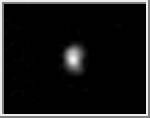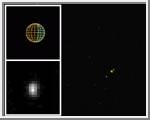
Jupiter VI
Himalia [hih-MAL-yuh] is the tenth known satellite of Jupiter and is the brightest of Jupiter's outer satellites. Himalia is most likely an irregularly shaped asteroid that was captured into orbit around Jupiter. In mythology, Himalia was a nymph who bore three sons of Zeus (Jupiter).
| Himalia Statistics | |
|---|---|
| Discovered by | C. Perrine |
| Date of discovery | 1904 |
| Mass (kg) | 9.56e+18 |
| Mass (Earth = 1) | 1.5997e-06 |
| Equatorial radius (km) | 93 |
| Equatorial radius (Earth = 1) | 1.4581e-02 |
| Mean density (gm/cm^3) | 2.8 |
| Mean distance from Jupiter (km) | 11,480,000 |
| Rotational period (days) | 0.4 |
| Orbital period (days) | 250.5662 |
| Mean orbital velocity (km/sec) | 3.34 |
| Orbital eccentricity | 0.1580 |
| Orbital inclination (degrees) | 27.63 |
| Escape velocity (km/sec) | 0.117 |
| Visual geometric albedo | 0.03 |
| Magnitude (Vo) | 14.84 |
 Himalia
Himalia
The brightest of Jupiter's outer satellites, Himalia, was captured and resolved, for the
first time, in a series of narrow angle images taken on December 19, 2000 from a
distance of 4.4 million kilometers during the brief period when Cassini's attitude was
stabilized by thrusters instead of reaction wheels. This particular 1.0 second exposure
was one of the sharpest, with a resolution of ~ 27 km/pixel, and was taken through a
near-infrared spectral filter at 1:07 UTC (spacecraft time). The arrow indicates
Himalia. North is up. The inset shows the satellite magnified by a factor of 10 and a
graphic indicating Himalia's size and phase (the sunlight is coming from the left). It is
likely that Himalia is not spherical: it is believed to be a body captured into orbit around
Jupiter and as such, is likely to be an irregularly shaped asteroid. At the time this image
was acquired, the dimensions of the side of Himalia facing the cameras is roughly 160
km in the up/down direction.
(Courtesy NASA/JPL/University of Arizona)
 Himalia
Himalia
This shows an expanded view of Jupiter's satellite Himalia.
(Courtesy NASA/JPL/University of Arizona)

 Jupiter
Jupiter Leda
Leda Lysithea
Lysithea